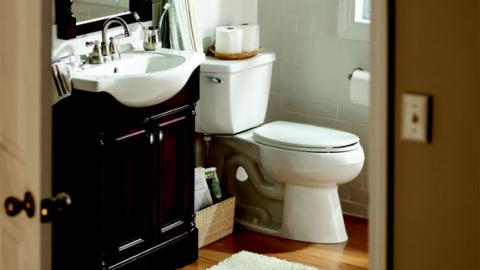
The following guest post is written by Chris Long from Home Depot.
---------------
When you think about the most effective places in a home to remove waste, kitchens and bathrooms probably top your list. After all, kitchens with their trash cans and garbage disposals make getting rid of waste a cinch and toilets, well, without toilets in our bathrooms we'd have to venture outside on a daily basis!
But what about another type of waste that occurs in the bathroom that we want to eliminate? In other words, even though the bathroom is effective at removing waste, is it as efficient as it should be?
Of course, the other kind of "waste" we want to wipe out in the bathroom refers to wasted energy! From water to electricity, the bathroom is one of the main sources of wasted energy in the home and the biggest culprits are those inefficient fixtures including everything from shower heads to light sockets.
Fortunately, there are simple ways to fight to keep more of these precious resources from getting flushed down the toilet; which also keeps more of our hard-earned money from washing down the drain. Here are some eco-friendlier updates for those wasteful plumbing fixtures in the bathroom.
Toilets
Although most people assume the shower is the worst water waster in the home, bathtubs get a bum rap (relatively speaking) because the biggest bad boy is actually the toilet.
Indeed, 30% or more of your household water usage is directly attributable to your toilet. But with toilets that are backed by the EPA's WaterSense seal of approval, you can cut that consumption by 20%.
While we're on the subject of WaterSense, in order for the EPA to certify a product as genuinely water efficient, the product:
- Must be at least 20% more water efficient than other products in the category (faucets, toilets, etc.).
- Must provide measurable results that help to realize water savings on a national level.
- Must achieve water efficiency through multiple technology options.
- Receives independent testing and third-party verification and certification that all guidelines have been followed and criteria met.
Basically, the WaterSense label is to fixtures that are more water efficient what the Energy Star label is to more energy-efficient appliances. All in all, looking for those labels on any products you purchase can help ensure you go far in your greener endeavors!
Due to the often cost prohibitive replacement expense, a simple DIY option for reducing your toilet's water waste is outfitting your existing toilet with a dual flush option.
BlueSource HydroRight Dual-Flush Converter
This dual flush converter provides the ease and efficiency of a two-flush option toilet with your current unit without requiring you to remove the tank or utilize complicated plumbing supplies. Plus, you still get the same amount of power for your full-flush option but now you have the added bonus of a low-flow flush.
*Tip: While converter kits typically fit most modern toilets, if you have an exceptionally old model (pre-1994), make sure the kit you purchase will satisfy the specifications of your toilet.
Faucets
For a faucet to receive the "all clear" in the EPA's water efficiency department, it must allow no more than 1.5 gallons of water per minute (GPM).
When you consider that swapping out your old faucets and aerators with WaterSense models can save an average family of four 700 gallons of water per year, or the amount of water you could use in 40 showers, without doing anything extra to save water, you start to see just how much Sense the switch makes!
*Tip: Simply turning off the faucet while you brush your teeth can save an average of 8 gallons of water per day - that's nearly 3,000 gallons annually per person!
NEOPERL 1.0 GPM Super-Saving Faucet Aerator Insert
A money and water saving idea - instead of replacing all of your faucets - is to simply replace your current faucet aerators with WaterSense attachments. This step alone can save up to 55% water when compared to the standard 2.2 GPM aerators (on non-water-efficient faucet fixtures).
*Tip: Be sure to take your existing aerator with you when you go to purchase a replacement. Simply unscrew the tip of your faucet and remove the tiny aerator insert inside.
Shower Heads
One of the best aspects of swapping out your 2.5 GPM or more water hogging shower head with a newer low-flow model that uses 2.0 GPM or less (many coming in around 1.5 GPM!) is the cross-resource savings that you receive: not only do you curb your water usage, but you can also cut costs in the energy department by having less water to heat! Win-win.
*Tip: While you wait for your shower water to heat up, catch all that cool water that would otherwise run down the drain. Keep a clean bucket next to your bathtub and use it every time you take a shower. From there, use it for everything from watering your garden to refilling Fido's water bowl or even helping a load of laundry use less water!
Light Fixtures
Don't forget about the other fixtures in your bathroom - your light fixtures.
By replacing your current incandescent bulbs with new LED bulbs, like this one from Cree, you can conserve up to 84% more energy.
Plus, these don't heat up like old school light bulbs which make them ideal for a bathroom - no more melting makeup!
What other DIY water and energy-efficient measures or updates have you undertaken in the bathroom?
Chris Long is a Home Depot store associate in the Chicago suburbs. He writes on plumbing and bathroom DIY for the Home Depot website. Chris' advice focuses on everything from toilet repair to plumbing fixtures.

Post new comment